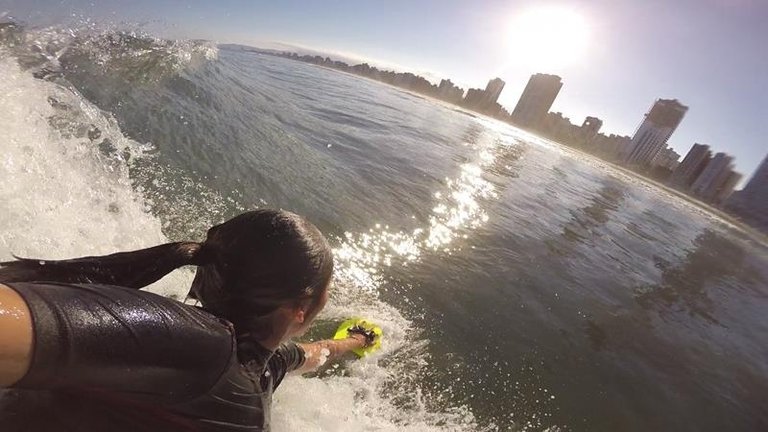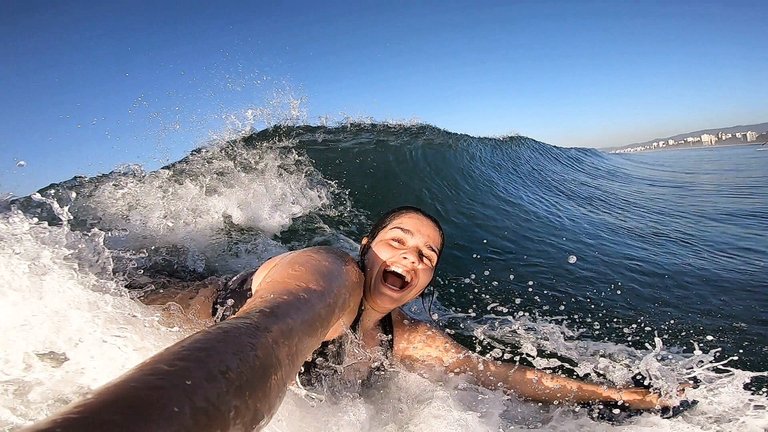English [🇺🇸]
Hi everyone!
You've already noticed how I like to talk about the sea here at Hive, right? More specifically about bodysurfing and handsurfing. And today I bring here the best tips for everyone who wants to learn to surf this way. But what then? Have you ever made your body your surfboard? Many don't know, but bodysurfing is the most primitive and natural way of gliding over the waves.
Foto: Um dia feliz de handsurf.
And over time, seeking to gain speed and reduce body friction in the water, bodysurfers began to test some objects in their hands. Among them, flip-flops, small pieces of wood and even fast food trays were used in the hand to surf. Until, around the 60s, an Australian company manufactured the first handboard, from the English “handboard” and today you will learn how to use this equipment and “get your head around” in the session!
Initially, remember that just like any other sport practiced at sea, it is important to know how to swim! Oh and you will need fins (fins) to be able to surf well and safely, giving you more momentum and mobility in the water.
In the first phase of learning you will catch waves that have already broken, that is, you will surf the foam of the wave. To do this, head to the inside (which is the part of the sea closest to the sand and where the waves have already broken) and get used to the sea. As soon as a breaking wave approaches you, throw your body forward and let the wave carry you as far as possible. A tip that will help you a lot: keep your body well aligned on the surface of the water (lock your abs!) to promote hydrodynamics and kick around.

Photo: Session in the late afternoon.
Train hard until you feel ready for the next level and try to catch the waves that haven't broken yet, that is, out there. The main secret is timing, that is, if you understand the timing of the wave and the moment you need to launch yourself into it, everything will become simpler. Remember to take advantage of the propulsion that the fins offer us, so take (a lot of) kicks!
You may be swallowed by the wave on your first attempts, but this is common. It is no reason for frustration and giving up. And as you practice, there will come a time when you catch the waves of the series. For this to happen in the best way possible, it is essential to have practiced on smaller waves, to have learned the timing of the waves and to know how to behave in the line up (where surfers are waiting for the series to catch the waves) without causing accidents. Pay attention not to collide with the surfers, as you are the most fragile figure in the sea as the others have boards with sharp fins that could hurt you.
Do you want a more complete tutorial than this one? Watch this video!
Aloha, see you soon!
About me My social networks: Aloha, galera! Vocês já perceberam como eu gosto de falar do mar aqui na hive, certo? Mais especificamente sobre bodysurf e handsurf. E hoje eu trago aqui as melhores dicas para todas as pessoas que queiram aprender a surfar dessa forma. Mas e então? Você já fez do seu corpo a sua prancha de surf? Muitos não sabem, mas o bodysurf é a forma mais primitiva e natural de deslizar sobre as ondas. E ao longo do tempo, buscando ganhar velocidade e diminuir o atrito do corpo na água, bodysurfers começaram a testar alguns objetos na mão. Dentre eles, chinelos, pequenos pedaços de madeira e até mesmo bandejas de fast food foram utilizadas na mão para surfar. Até que, por volta dos anos 60, uma empresa australiana fabricou a primeira handboard, do inglês “prancha de mão” e hoje você vai aprender como usar esse equipamento e “fazer a cabeça” na session! Inicialmente, lembre-se que assim como qualquer outro esporte praticado no mar, é importante saber nadar! Ah e você vai precisar de nadadeiras (pé de pato) para conseguir surfar bem e em segurança, te dando mais impulso e mobilidade na água. Na primeira fase do aprendizado você vai pegar ondas que já quebraram, ou seja, você vai surfar na espuma da onda. Para isso, dirija-se para o inside (que é a parte do mar mais próxima da areia e onde as ondas já quebraram) e vá se ambientando no mar. Assim que uma onda que já quebrou se aproximar de você, lance seu corpo à frente e deixe a onda te levar o mais longe possível. Uma dica que vai te ajudar bastante: mantenha o corpo bem alinhado na superfície da água (trava o abdômen!) para favorecer a hidrodinâmica e dê pernadas. Treine bastante até que você se sinta pronto para o próximo nível e tente pegar as ondas que ainda não quebraram, ou seja, lá no outside. O segredo principal está no timing, ou seja, se você entender o tempo da onda e o momento que você precisa se lançar nela, tudo ficará mais simples. Lembre-se de aproveitar a propulsão que as nadadeiras nos oferecem, então dê (muitas) pernadas! Talvez você seja engolido pela onda nas suas primeiras tentativas, mas isso é algo comum. Não é motivo para frustração e desistência. E conforme você for praticando, chegará um momento em que irá pegar as ondas da série. Para isso acontecer da melhor forma possível, é essencial ter praticado em ondas menores, ter pegado o timing das ondas e saber como se comportar no line up (onde os surfistas ficam esperando a série para pegar as ondas) sem causar acidentes. Preste atenção para não colidir com os surfistas, pois você é a figura mais frágil no mar uma vez que os outros possuem pranchas com quilhas afiadas que podem te machucar. Quer um tutorial mais completo que esse? Assista a esse vídeo! Aloha, até a próxima! Sobre mim Minhas redes sociais:
Physical education teacher, PhD student, content creator, bodysurfer and nature lover. Get to know me better here!
Instagram: @parada.leticia
YouTube: Ela No Mar
LinkedIn: https://br.linkedin.com/in/leticia-parada-657883249
Português [BR]
Foto: Um dia feliz de handsurf. 
Foto: Session no final da tarde.
Professora de educação física, doutorado em andamento, criadora de conteúdo, bodysurfer e amante da natureza. Clica aqui pra me conhecer melhor!
Instagram: @parada.leticia
YouTube: Ela No Mar
LinkedIn: https://br.linkedin.com/in/leticia-parada-657883249

Obrigado por promover a comunidade Hive-BR em suas postagens.
Vamos seguir fortalecendo a Hive
Mahalo
Finally! Somebody else brings a camera into the water! Lovely shots!
Thank you very much! I love photographing in the water and I like to show a little of my world at sea.
Your post was manually curated by @michupa.
Delegate your HP to the hive-br.voter account and earn Hive daily!
🔹 Follow our Curation Trail and don't miss voting! 🔹
TKS!